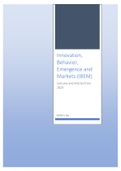Innovation,
Behavior,
Emergence and
Markets (IBEM)
Lectures and Articles from
2023
©2023 A. Arp
,Innovation, Behavior, Emergence and Markets
Lecture 1 Complex Systems
Objectives:
- To understand the various types of systems, among them CAS
- To identify the general visible and invisible properties of CAS
- To explain the underlying mechanisms and levels of adaptivity in CAS
- To describe the scientific base and some research fields of CAS
Complex Adaptive system = aa system which consists of independent elements/agents that interact
and move towards unpredictable outcomes. Things that comprehend complex adaptive systems:
- Complex = difficult to understand or difficult to predict
- Dynamic = changing, moving
- Adaptive = changing to adapt to an environment or condition.
System = elements that are interconnected. System can be simple, complicated, non-linear (chaotic),
CAS. Non-linear and CAS means is also dynamic.
Ex: simple system is a bike. Has simple things and is easy to repair. Complicated system is for example
a plane. Can become very complex to solve a problem, can be overwhelming amount of parts to think
about.
Reductionism = you can understand a system completely if you know the properties of all its
elements. CAS are partly unpredictable, show emergence, are partly irrational, even if you know all
things. 1+1+1 = 3, all parts work together to a goal.
Non-linear system = continuously changing and is unpredictable. Many things, but no thinking or
adaptation. Input-output relations unclear. 1+1=3, because separate elements do not resemble the
productivity of the system. There is no simple relationship between a change and the reaction of the
system (no simple cause-effect relation).
- Butterfly-effect = a small change may cause a large effect
- Difficult to control and change
• A small change may cause no effect (stability), unexpected effect (emergence) or a
large effect across a transition point.
• A large change may cause: no effect (resilience, stability, adaptation), a minor local
effect, unexpected effect (emergence) or a large effect across a transition point.
Ex: weather, chaotic and unpredictable.
Characteristics Complex Adaptive System
1. Leaderless (decentralized)
2. Non-linear
3. Emergent patterns. Patterns that form even though the agents were not directed to make a
pattern.
4. Self-organizing. A system in which a pattern emerges as a result of the agents following
simples rules without external control or a leader.
5. Feedback loop. Can be positive or negative changes (phase transition). Small initial change
can change up the whole system. A closed system that contains a circular process in which
the system’s output is returned or “fed back” to the system as input.
6. Adaptive. Degree of autonomy and responsibility which leads to self-organization → bottom-
up change.
7. Chaotic behavior of a system. Small changes in initial conditions can generate large changes
in the system’s outcome.
1
, 8. Stochastic. Governed by chance (luck). There is an element of randomness. The behavior of a
complex adaptive system can be inherently stochastic as elements of the system, the agents,
can have randomness in their movement, and thus, in their interactions.
CAS:
- Contain many diverse and specialized agents, components or parts in an intricate
arrangement, which are the building blocks.
- Adaptive as they have the capacity to change under influence of feedback or memory (learn
from experience) and thus evolve, giving it resilience in the face of perturbation.
- Are usually open systems: system interacts with its environment which permits feedback.
- Show emergence: the whole is more than the sum of the components and the very specific
connectivity creates a new property.
- Operate far from equilibrium: there has to be a constant input of energy to maintain the
organization of the system, and this is essential for emergence.
How do CAS react to changes?
1) sometimes a small change may have a large effect (butterfly effect) or
2) the system is resistant (resilient) against a disturbance or
3) evolution, specialization of the actors.
Examples of CAS: ecosystem, health care system, city, organizations (like a hospital), market (business
ecosystem), artificial systems (games), gut, a master’s course.
Visible CAS properties:
1. Diversity/specialization of actors
2. Changing behavior by actors
3. Boundaries, but they are permeable
4. Adaptation and behavioral change (learning)
5. Tags: a visible code to easily identify an actor (useful for other actors)
6. Struggle and survival / competition between actors
7. Reward mechanisms: they determine how actor behave
8. Strategies: actors think how they can do better/survive
Adaptation + rewards + strategies result in
1) Selection: failure of the weak- and success for the fittest
2) Inequality: a CAS is unfair (some are rich, most are poor)
3) Continuous change (a CAS is unpredictable)
Invisible CAS properties:
1. Several equilibrium points
2. Transition points lead to switching between forms
3. Perturbations (big or small critical events) may cause a jump to a new equilibrium point.
Ex: revolution, new organizational structure, collapse of an ecosystem, epidemic disease.
4. Cause-effect relations are non-linear: cannot calculate effect of a change.
5. Resistant to change (resilient)
6. Stays close to equilibrium/stable form; small changes do not disturb the system.
Internal model (schemata) = carrier of adaptivity. Also called a scheme. Is an actor’s model of its
environment in a form that describes how to behave. Can change by coincidence (mutation), by
design (programming) or by learning from experiences.
- A good internal model helps its owners to survive, because the actor reacts better next time
- Internal models vary from very simple to very complicated.
- Can be stored in the brain, DNA, text (recipe, BP, bible, protocol) or software/algorithm (AI).
2




